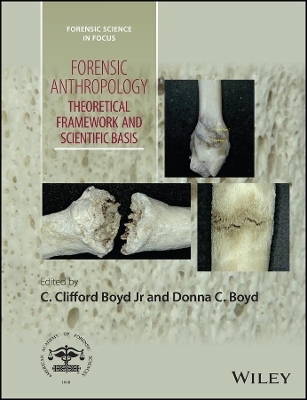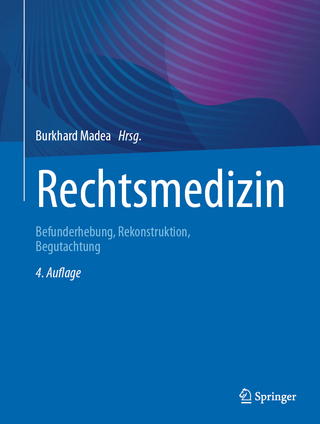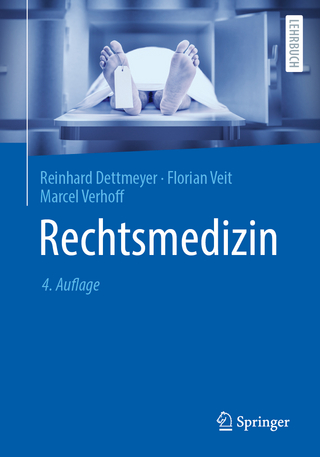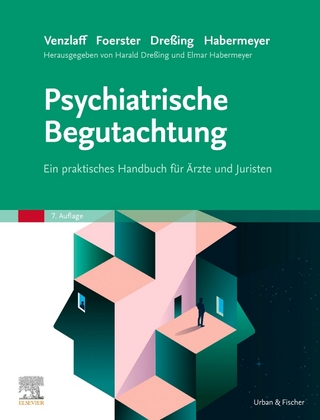
Forensic Anthropology
John Wiley & Sons Inc (Verlag)
978-1-119-22638-3 (ISBN)
Forensic anthropology has been plagued by questions of scientific validity and rigor despite its acceptance as a section in the American Academy of Forensic Sciences nearly half a century ago. Critics have viewed it as a laboratory-based applied subfield of biological anthropology, and characterised it as emphasising methodology over theory. This book shows that these views are not only antiquated, but inadequate and inaccurate.
Forensic Anthropology: Theoretical Framework and Scientific Basis introduces readers to all of the theoretical and scientific foundations of forensic anthropology — beginning with how it was influenced by the early theoretical approaches of Tyler, Morgan, Spencer and Darwin. It instructs on how modern forensic science relies on an interdisciplinary approach — with research being conducted in the fields of archaeology, physics, geology and other disciplines. This modern approach to theory in forensic anthropology is presented through the introduction and discussion of Foundational, Interpretive and Methodological theories. Sections cover: Bias and Objectivity in Forensic Anthropology Theory and Practice; The Theory and Science Behind Biological Profile and Personal Identification; Scientific Foundation for Interpretations of Antemortem, Perimortem, and Postmortem Processes; and Interdisciplinary Influences, Legal Ramifications and Future Directions.
Illustrates important aspects of the theory building process and reflects methods for strengthening the scientific framework of forensic anthropology as a discipline
Inspired by the “Application of Theory to Forensic Anthropology” symposium presented at the 67th annual meeting of the American Academy of Forensic Sciences
Chapters written by experts in the field who were presenters at the symposium
Forensic Anthropology: Theoretical Framework and Scientific Basis is ideal for university courses in anthropological science, forensic science, criminal science and forensic archaeology.
Edited by C. Clifford Boyd Jr, PhD, RPA, is currently a Professor of Anthropological Sciences at Radford University, Virginia, Co-Director of the RU Forensic Science Institute, and Consultant for the Virginia Office of the Chief Medical Examiner. Donna C. Boyd, PhD, D-ABFA, is Eminent Professor of Anthropological Sciences at Radford University, Co-Director of the RU Forensic Science Institute, Professor of Biomedical Science at Virginia Tech Carilion School of Medicine, and Consultant for the Virginia Office of the Chief Medical Examiner.
About the Editors xv
Notes on contributors xvii
Foreword xxiii
Series preface xxv
Acknowledgments xxvii
1 The theoretical and scientific foundations of forensic anthropology 1
C. Clifford Boyd Jr and Donna C. Boyd
1.1 Introduction 1
1.2 A selective history of theory in forensic anthropology 2
1.3 A modern perspective on forensic anthropology theory 5
1.3.1 Three forms of logical reasoning 8
1.3.2 Theory building in forensic anthropology: Linking logic and theory 10
1.4 Forensic anthropology theory and modern practice 12
1.5 Final comments 15
References 15
Part 1 Bias and objectivity in forensic anthropology theory and practice 19
2 Subjective with a capital S? Issues of objectivity in forensic anthropology 21
Allysha Powanda Winburn
2.1 Introduction 21
2.2 Objectivity subjectivity and forensic anthropological theory 22
2.3 Subjectivity in science 24
2.3.1 Subjectivity in forensic anthropology 24
2.3.2 Effects of bias on forensic anthropology 25
2.3.3 Subjective science is not bad science 26
2.4 Mitigated objectivity: A path forward… 27
2.4.1 Constraining subjectivity and bias 28
2.4.2 The continuing process of constraint 33
2.5 Conclusion 34
References 34
3 Navigating cognitive bias in forensic anthropology 39
Michael W. Warren Amanda N. Friend and Michala K. Stock
3.1 Introduction 39
3.2 Types of cognitive bias 40
3.3 Research versus applied science 41
3.4 Recommended solutions to mitigate confirmation bias 43
3.5 Challenges unique to forensic anthropology 44
3.5.1 Anthropologists work in a variety of professional contexts 44
3.5.2 The uniqueness of the forensic anthropology testing sample 45
3.5.3 Multiple tests to reach a single conclusion 45
3.6 An example of how bias affects procedures 46
3.7 Workable solutions 49
3.8 Summary 49
References 50
4 Theoretically interesting: Different perspectives of the application of theory to forensic anthropology practice and research 53
Soren Blau
4.1 Introduction 53
4.2 Practising in context 56
4.3 Ethical considerations for the development of theory 58
4.4 Can theories be applied universally? 59
4.5 Conclusion 59
Acknowledgements 61
References 61
Part 2 The theory and science behind biological profile and personal identification 65
5 From Blumenbach to Howells: The slow painful emergence of theory through forensic race estimation 67
Stephen Ousley Richard L. Jantz and Joseph T. Hefner
5.1 Introduction 67
5.2 Race as a concept and theory 68
5.2.1 Evolution rather than race explains human biological variation 70
5.2.2 Human variation is continuous 72
5.2.3 Human biological variation involves many traits that typically vary independently 73
5.2.4 Genetic variation within so‐called races is much greater than the variation among them 74
5.2.5 There is no way to consistently classify human beings by race 75
5.3 Anthropology and race 79
5.4 Forensic anthropology and race 85
5.5 Race and the future 90
Acknowledgments 92
References 92
6 The application of theory in skeletal age estimation 99
Natalie R. Langley and Beatrix Dudzik
6.1 Introduction 99
6.2 Skeletal age 101
6.3 Historical context 101
6.4 Forensic anthropology and evolutionary biology 102
6.5 Potential solutions to the problem of age estimation 105
6.6 Final comments 107
References 109
7 Theory and histological methods 113
Christian M. Crowder Deborrah C. Pinto Janna M. Andronowski and Victoria M. Dominguez
7.1 Introduction 113
7.2 Foundational theory in bone biology 114
7.3 Interpretive theory in bone biology 115
7.3.1 Form and function 115
7.3.2 The mechanostat and Utah paradigm 116
7.3.3 Exploring the effectors of the mechanostat 117
7.4 Methodological theory in bone biology 119
7.4.1 Histological age estimation 120
7.4.2 Determining human versus nonhuman bone 121
7.5 Conclusions 122
References 123
8 Forensic applications of isotope landscapes (“isoscapes”): A tool for predicting region‐of‐origin in forensic anthropology cases 127
Lesley A. Chesson Brett J. Tipple James R. Ehleringer Todd Park and Eric J. Bartelink
8.1 Introduction 127
8.2 What are isotopes? 128
8.3 Why do isotope compositions of human tissues differ? 129
8.3.1 Hydrogen and oxygen isotopes 130
8.3.2 Strontium isotopes 130
8.3.3 Carbon nitrogen and sulfur isotopes 132
8.4 How do we interpret isotope data collected for forensic human identification? 133
8.4.1 Oxygen isotopes in drinking water and hair keratin 134
8.4.2 Oxygen isotopes in drinking water and skeletal bioapatite 137
8.4.3 Strontium isotopes of local bedrock and skeletal remains 138
8.5 Examples of the application of isotope analysis to unidentified remains 139
8.5.1 Jane Doe from Salt Lake County 139
8.5.2 Mandible from Siskiyou County 141
8.6 What are the future applications of isotope analysis? 144
Acknowledgments 144
References 145
Part 3 Scientific foundation for interpretations of antemortem perimortem and postmortem processes 149
9 The anatomical basis for fracture repair: Recognition of the healing continuum and its forensic applications to investigations of pediatric and elderly abuse 151
Donna C. Boyd
9.1 Introduction: Diagnosing pediatric and elderly non‐accidental injury 151
9.2 Theoretical basis for fracture healing and TSI estimation 153
9.3 Anatomical basis for fracture healing 154
9.3.1 Bone growth and development 155
9.3.2 Fracture healing 157
9.4 Factors affecting the rate of bone healing 162
9.4.1 The biological profile (age sex ancestry) 162
9.4.2 Type location cause severity and number of injuries 163
9.4.3 Injury treatment and local biomechanical factors 164
9.4.4 Systemic and other factors 165
9.5 Fracture healing stages and dating systems 166
9.6 A new model for fracture repair 174
9.7 Expanding and refining TSI estimation through the Antemortem Fracture Archive 181
9.8 Theory and the future of TSI estimation 184
References 184
Appendix A 195
Major fracture repair stages and TSI estimations 195
10 Theoretical foundation of child abuse 201
Jennifer C. Love and Miriam E. Soto Martinez
10.1 Introduction 201
10.2 Case study 201
10.3 Anthropologists and child abuse 202
10.4 Foundational theory 203
10.5 Interpretive theory 204
10.5.1 Bone biomechanics 205
10.5.2 Motor skill development 207
10.6 Methodological theory 207
10.7 Conclusion 209
References 209
11 Bone trauma analysis in a forensic setting: Theoretical basis and a practical approach for evaluation 213
Hugh E. Berryman John F. Berryman and Tiffany B. Saul
11.1 Introduction 213
11.2 Theory 214
11.2.1 Foundational theory 215
11.2.2 Interpretive theory 216
11.2.3 Methodological theory 217
11.3 Fundamental principles in bone fracture interpretation 218
11.4 A practical approach to bone trauma evaluation and hypothesis building 226
11.5 Conclusion 232
References 232
12 Thinking outside the box: Theory and innovation in sharp trauma analysis 235
John A. Williams and Ronald W. Davis
12.1 Introduction 235
12.2 Transfer of evidence 235
12.3 Theory connections 236
12.4 The human skeleton as transfer evidence 237
12.5 A primer on saws and dismemberment 238
12.6 Geographic information system 240
12.7 Applications of GIS in forensic anthropology and human osteology 241
12.8 GIS: innovation in cut mark striation interpretation 242
12.9 Locard and the twenty‐first century: It’s all a matter of scale 247
References 248
13 The forensic anthropologist as broker for cross‐disciplinary taphonomic research related to estimating the postmortem interval in medicolegal death investigations 251
Daniel J. Wescott
13.1 Introduction 251
13.2 Taphonomy and taphonomic theory 252
13.3 Forensic taphonomy 254
13.4 Taphonomy and the estimation of time since death 255
13.5 The necrobiome 256
13.6 Cross‐disciplinary research 257
13.6.1 Need for cross‐disciplinary research in PMI estimation 257
13.6.2 Cross‐disciplinary approaches 258
13.7 Overcoming barriers to cross‐disciplinary research 262
13.8 Forensic anthropologists as brokers for unified theories in forensic taphonomy 264
13.8.1 Forensic anthropologists are already major players 264
13.8.2 Anthropologists have a long history of conducting taphonomic research 264
13.8.3 Anthropology is traditionally a holistic field 265
13.8.4 Forensic anthropology has its roots in academic research 265
13.9 Conclusions 265
Acknowledgments 266
References 266
Part 4 Interdisciplinary influences legal ramifications and future directions 271
14 Archaeological inference and its application to forensic anthropology 273
C. Clifford Boyd Jr and William W. Baden
14.1 Introduction 273
14.2 Agency and nonlinear systems theories 274
14.3 Nonlinear modeling of the decomposition process 277
14.4 Discussion 284
References 292
15 Arrows of influence: The give and take of theory between forensic anthropology archaeology and geophysics 297
John F. Schweikart and Cheryl A. Johnston
15.1 Introduction 297
15.2 Influences of archaeology on forensic anthropology 299
15.3 Influences of geophysics on forensic anthropology 301
15.4 “Backflow” to other disciplines: Site formation processes in archaeology 302
15.5 Backflow: Interpretation/understanding of geophysical signatures 303
15.6 Conclusion 305
References 305
16 Forensic anthropology scientific evidence and the law: Why theory matters 307
Donna C. Boyd and C. Clifford Boyd Jr
16.1 Introduction: Theory in practice 307
16.1.1 Commonwealth of Virginia V Lockett: Why theory matters 307
16.2 Science and the law: The disconnect 309
16.3 Science and the law: Commonalities 310
16.3.1 Legal and scientific dialogue 310
16.3.2 Abductive reasoning 311
16.3.3 Probabilistic evaluation of the strength of evidence 312
16.4 Forensic anthropologists as expert witnesses 315
16.5 Admissibility of forensic anthropology evidence in the post‐Daubert world 316
16.6 The legal application of forensic anthropology: Why theory matters 318
16.7 Final comments 319
Acknowledgments 320
References 320
17 Epilogue: Theory and science in forensic anthropology: Avenues for further research and development 325
C. Clifford Boyd Jr and Donna C. Boyd
17.1 The science of forensic anthropology 325
17.2 Looking forward 327
References 328
Index 329
| Erscheinungsdatum | 13.06.2018 |
|---|---|
| Reihe/Serie | Forensic Science in Focus |
| Verlagsort | New York |
| Sprache | englisch |
| Maße | 178 x 257 mm |
| Gewicht | 953 g |
| Themenwelt | Studium ► 2. Studienabschnitt (Klinik) ► Rechtsmedizin |
| Naturwissenschaften ► Biologie | |
| Naturwissenschaften ► Chemie ► Analytische Chemie | |
| Sozialwissenschaften ► Ethnologie | |
| Sozialwissenschaften ► Soziologie | |
| ISBN-10 | 1-119-22638-4 / 1119226384 |
| ISBN-13 | 978-1-119-22638-3 / 9781119226383 |
| Zustand | Neuware |
| Haben Sie eine Frage zum Produkt? |
aus dem Bereich


